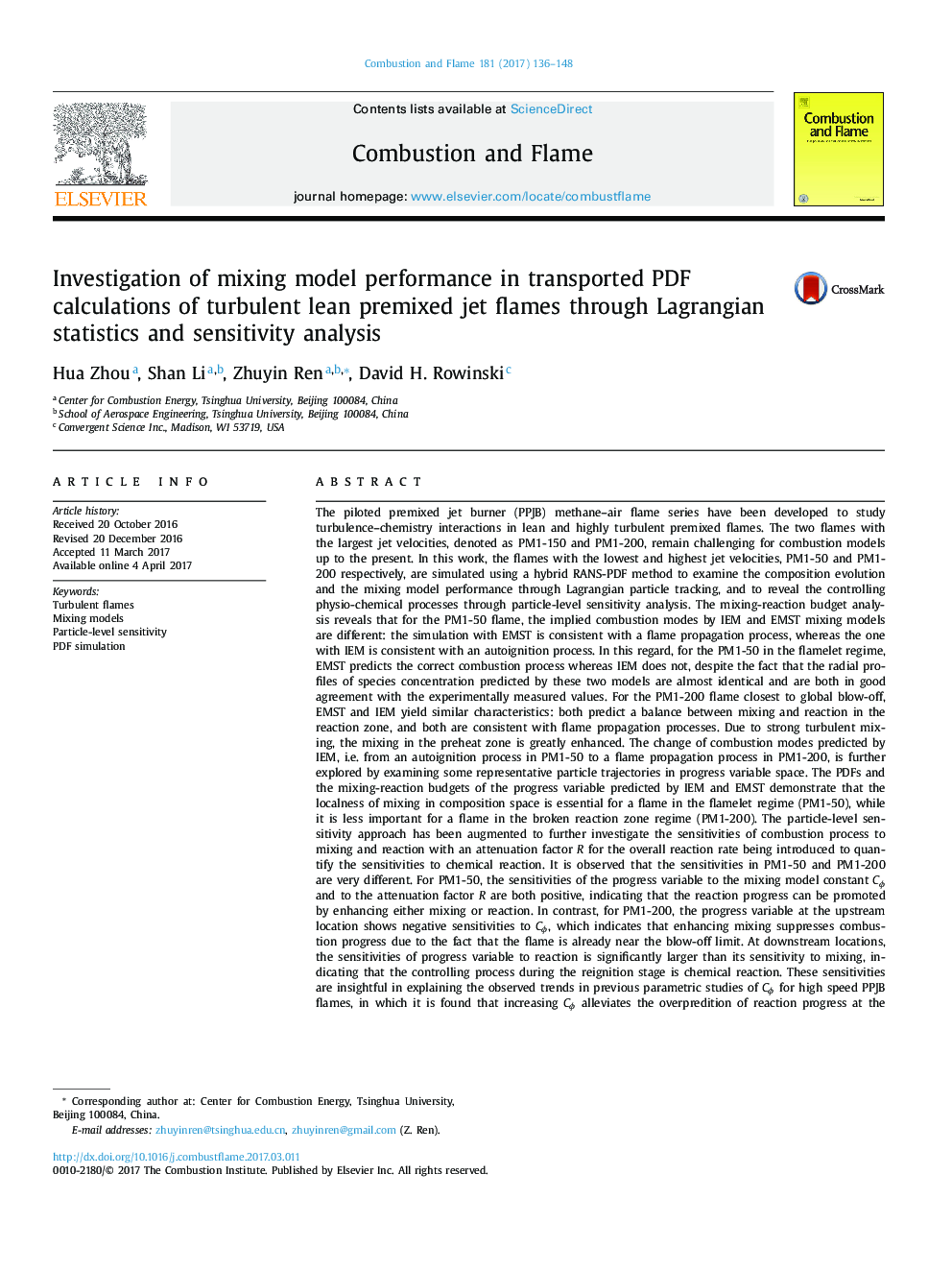| کد مقاله | کد نشریه | سال انتشار | مقاله انگلیسی | نسخه تمام متن |
|---|---|---|---|---|
| 6468195 | 1423556 | 2017 | 13 صفحه PDF | دانلود رایگان |

The piloted premixed jet burner (PPJB) methane-air flame series have been developed to study turbulence-chemistry interactions in lean and highly turbulent premixed flames. The two flames with the largest jet velocities, denoted as PM1-150 and PM1-200, remain challenging for combustion models up to the present. In this work, the flames with the lowest and highest jet velocities, PM1-50 and PM1-200 respectively, are simulated using a hybrid RANS-PDF method to examine the composition evolution and the mixing model performance through Lagrangian particle tracking, and to reveal the controlling physio-chemical processes through particle-level sensitivity analysis. The mixing-reaction budget analysis reveals that for the PM1-50 flame, the implied combustion modes by IEM and EMST mixing models are different: the simulation with EMST is consistent with a flame propagation process, whereas the one with IEM is consistent with an autoignition process. In this regard, for the PM1-50 in the flamelet regime, EMST predicts the correct combustion process whereas IEM does not, despite the fact that the radial profiles of species concentration predicted by these two models are almost identical and are both in good agreement with the experimentally measured values. For the PM1-200 flame closest to global blow-off, EMST and IEM yield similar characteristics: both predict a balance between mixing and reaction in the reaction zone, and both are consistent with flame propagation processes. Due to strong turbulent mixing, the mixing in the preheat zone is greatly enhanced. The change of combustion modes predicted by IEM, i.e. from an autoignition process in PM1-50 to a flame propagation process in PM1-200, is further explored by examining some representative particle trajectories in progress variable space. The PDFs and the mixing-reaction budgets of the progress variable predicted by IEM and EMST demonstrate that the localness of mixing in composition space is essential for a flame in the flamelet regime (PM1-50), while it is less important for a flame in the broken reaction zone regime (PM1-200). The particle-level sensitivity approach has been augmented to further investigate the sensitivities of combustion process to mixing and reaction with an attenuation factor R for the overall reaction rate being introduced to quantify the sensitivities to chemical reaction. It is observed that the sensitivities in PM1-50 and PM1-200 are very different. For PM1-50, the sensitivities of the progress variable to the mixing model constant CÏ and to the attenuation factor R are both positive, indicating that the reaction progress can be promoted by enhancing either mixing or reaction. In contrast, for PM1-200, the progress variable at the upstream location shows negative sensitivities to CÏ, which indicates that enhancing mixing suppresses combustion progress due to the fact that the flame is already near the blow-off limit. At downstream locations, the sensitivities of progress variable to reaction is significantly larger than its sensitivity to mixing, indicating that the controlling process during the reignition stage is chemical reaction. These sensitivities are insightful in explaining the observed trends in previous parametric studies of CÏ for high speed PPJB flames, in which it is found that increasing CÏ alleviates the overpredition of reaction progress at the upstream location but does not help improve the prediction at the downstream location where the controlling process is chemical reaction.
Journal: Combustion and Flame - Volume 181, July 2017, Pages 136-148